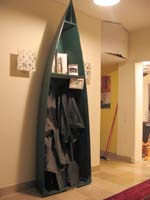Take-down Pirogue
Hi Chuck
Attached are photos of a pirogue (from a kit
from Uncle
John's) I built a year or so ago. I saw a similar
one (for a nesting canoe) in your design contest about a month
back, and thought about kicking in my two bits. Then today I
reinstalled my scanner, and I thought I would send you some
photos and a description. (Plus my subscription is up soon and
I thought this might buy me an extra month or two.)
 le mec (click to enlarge)
le mec (click to enlarge) |
I live in a third floor apartment in Cologne,
Germany, with a relatively small living room that my French
wife reluctantly allowed me to build a boat in (they don't call
them freedom wives for nothing). That put two constraints on
building a pirogue for me; storing the thing in the apartment
during the construction, and after, and how to get her down
three flights of stairs when I wanted put her in the water.
So I ended up building it in two pieces, each
with a transom. Essentially you make the thing like any other
simple cheap canoe/pirogue boat. But instead of scarfing the
sides and bottoms together, you join them to transoms. The sides
are 1/4" birch plywood, and the transoms are 1/2"
birch ply.
 (click to enlarge)
(click to enlarge) |
After building the two hulls I drilled through
the transoms, two holes near the top and two holes farther down,
but well above the water line, and bolted them together through
rubber spacers to help absorb any flexing stress. The removeable
gunwales were each laminated out of two 8-foot strips of 3/8"x1"x
8' clear pine. You epoxy the two pieces together and then clamp
them in place to take the curve of the sides permanently (wax
paper kept them from sticking to the sides). I added another
two strips of 3/8" x 1.5" clear white pine on the
insides of the two hulls to reinforce the hull where the removable
gunwales bolt through with carriage bolts and wing nuts. (This
is all pretty clear in the photos, I hope) Then you turn the
boat over and sandwich the keel over the gap between the two
hulls with two 2-foot strips of aluminum, drill through, and
bolt the thing together.
The paddles were made of left-over 1/4" ply
and a 1" dowel.

Because I was building in the living room, I
didn't think even my freedom wife would put up with a fiberglassing
job, so I built "Le Mec" (roughly, The Dude) with
epoxy and chine logs, pulled all the screws and replaced them
with wooden pegs, and just painted the plywood with a latex
house paint. We have had her out a couple of times, and she
handles about as well as any other more or less flat bottomed
canoe I have ever been in. With the removable gunwales and the
aluminum strips she does not flex. One thing is that the gap
between the two hulls under water seems to add some drag and
cuts Le Mec's top speed, so I added a strip of close-celled
foam in the gap and that helped. When not swimming the local
waters, Le Mec serves as a shelf in the living room and a coat
rack/shelf in our entrance hall and living room.
She is very light, about 20 pounds, and the two
pieces are very easy to handle up and down the stairs. It could
be that there are other apartment-living and frustrated pirogue
builders out there who might take inspiration from this method
of getting on the water. I hope so.
I also built another pirogue in the south of France
as a house present for some friends with a house on a river
we were staying with (actually it was our honeymoon (I have
a really good wife)) and "Le Ragondin" ("the
nutria" a kind of giant aquatic hamster that has infested
France, and the southern US since Napoleon decided to import
them to Lousiana and France to serve as fur animals), got her
maiden voyage on Le Gardon river in Provence in April. She was
basically the same design, but built in one piece. I just sort
of hacked her out of odds and ends of wood I tracked down in
the neighborhood there over a couple of days. Rough, but she
floats.
My next project will be based on the swamp boats
they use near my wife's home town in southwestern France. They
have a canoe stern for paddeling and a wider, scow front for
capacity. Mine will also have a rudder, lee board and small
sail. It will be a 5 mm ply, stitch-and-glue and fiberglass
job. The idea is to make a boat that is light enough to paddle
and portage easily, but with enough room to sleep at anchor
if I can't find a camping place for the night. I am a journalist
by trade and plan to take a trip down La Loire river in France
and write a book on the trip, with a little wine, food, history
and natural history thrown in. But we are expecting a baby in
June, so it might be a couple of years before I can put it all
together.
Take it easy and hope you are well.
Brian Anderson
Kleingedank Str. 10
Cologne, 50677 Germany
bawrytr@hotmail.com


